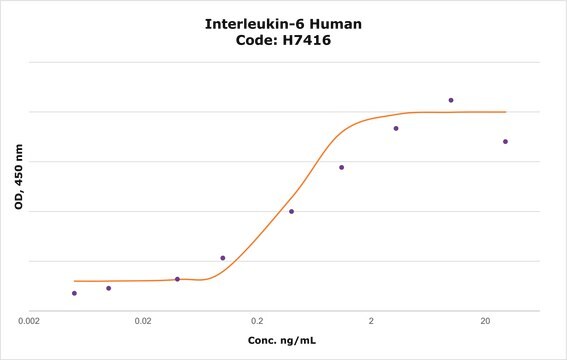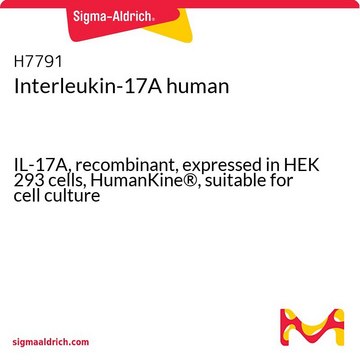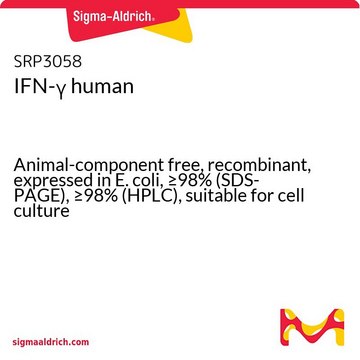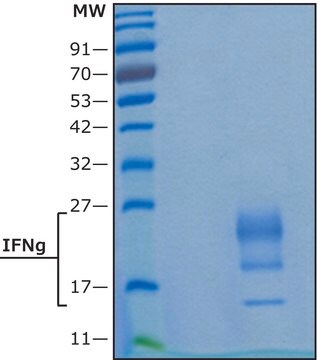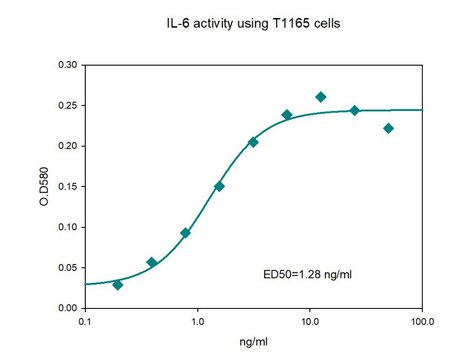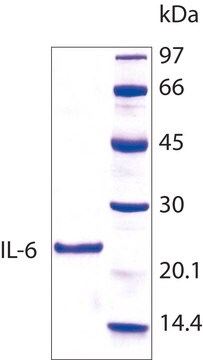SRP3075
IL-12p80 human
recombinant, expressed in (BTI-Tn-5B1-4) High-5 Insect Cells, ≥95% (SDS-PAGE), ≥95% (HPLC), suitable for cell culture
Sign Into View Organizational & Contract Pricing
All Photos(1)
About This Item
UNSPSC Code:
12352202
NACRES:
NA.32
Recommended Products
biological source
human
recombinant
expressed in (BTI-Tn-5B1-4) High-5 Insect Cells
Assay
≥95% (HPLC)
≥95% (SDS-PAGE)
form
lyophilized
mol wt
80.0 kDa
packaging
pkg of 10 μg
technique(s)
cell culture | mammalian: suitable
impurities
<0.1 EU/μg endotoxin, tested
color
white to off-white
UniProt accession no.
shipped in
wet ice
storage temp.
−20°C
Gene Information
human ... IL12B(3593)
General description
IL-12 is a disulfide-linked heterodimeric protein (p70), composed of two subunits, p35 and p40, which are encoded by two different genes. Accumulating data indicate that p40 secretion precedes that of IL-12 expression. In addition, to its ability to covalently bind to p35 to form IL-12, p40 can bind to p19 to form IL-23, or can form a homodimer designated as IL-12 p80. Elevated levels of IL-12 p80 are correlated with macrophage recruitment and increased inflammation in asthma and respiratory viral infection models. Recombinant human IL-12 p80 is an 80.0 kDa disulfide linked homodimer consisting of two p40 chains of IL-12.
Biochem/physiol Actions
IL-12 is a disulfide-linked heterodimeric protein (p70), composed of two subunits, p35 and p40, which are encoded by two different genes. Accumulating data indicate that p40 secretion precedes that of IL-12 expression. In addition, to its ability to covalently bind to p35 to form IL-12, p40 can bind to p19 to form IL-23, or can form a homodimer designated as IL-12 p80. Elevated levels of IL-12 p80 are correlated with macrophage recruitment and increased inflammation in asthma and respiratory viral infection models. Recombinant human IL-12 p80 is an 80.0 kDa disulfide linked homodimer consisting of two p40 chains of IL-12.
Sequence
p40 Subunit: IWELKKDVYV VELDWYPDAP GEMVVLTCDT PEEDGITWTL DQSSEVLGSG KTLTIQVKEF GDAGQYTCHK GGEVLSHSLL LLHKKEDGIW STDILKDQKE PKNKTFLRCE AKNYSGRFTC WWLTTISTDL TFSVKSSRGS SDPQGVTCGA ATLSAERVRG DNKEYEYSVE CQEDSACPAA EESLPIEVMV DAVHKLKYEN YTSSFFIRDI IKPDPPKNLQ LKPLKNSRQV EVSWEYPDTW STPHSYFSLT FCVQVQGKSK REKKDRVFTD KTSATVICRK NASISVRAQD RYYSSSWSEW ASVPCS
Physical form
Lyophilized from 10 mM Sodium Acetate, pH 5.6 + 90 mM NaCl + 2% Sucrose + 4.0% Mannitol.
Reconstitution
Centrifuge the vial prior to opening. Reconstitute in water to a concentration of 1.0 mg/ml. Do not vortex. This solution can be stored at 2-8°C for up to 1 week. For extended storage, it is recommended to further dilute in a buffer containing a carrier protein (example 0.1% BSA) and store in working aliquots at -20°C to -80°C.
Storage Class Code
11 - Combustible Solids
WGK
WGK 3
Flash Point(F)
Not applicable
Flash Point(C)
Not applicable
Certificates of Analysis (COA)
Search for Certificates of Analysis (COA) by entering the products Lot/Batch Number. Lot and Batch Numbers can be found on a product’s label following the words ‘Lot’ or ‘Batch’.
Already Own This Product?
Find documentation for the products that you have recently purchased in the Document Library.
M K Gately et al.
Journal of immunology (Baltimore, Md. : 1950), 147(3), 874-882 (1991-08-01)
IL-12 is a heterodimeric cytokine that was identified on the basis of its ability to synergize with IL-2 in the induction of cytotoxic effector cells and was originally called cytotoxic lymphocyte maturation factor (CLMF). IL-12 was also found to stimulate
M B Atkins et al.
Clinical cancer research : an official journal of the American Association for Cancer Research, 3(3), 409-417 (1997-03-01)
A Phase I dose escalation trial of i.v. administered recombinant human interleukin 12 (rhIL-12) was performed to determine its toxicity, maximum tolerated dose (MTD), pharmacokinetics, and biological and potential antineoplastic effects. Cohorts of four to six patients with advanced cancer
Our team of scientists has experience in all areas of research including Life Science, Material Science, Chemical Synthesis, Chromatography, Analytical and many others.
Contact Technical Service